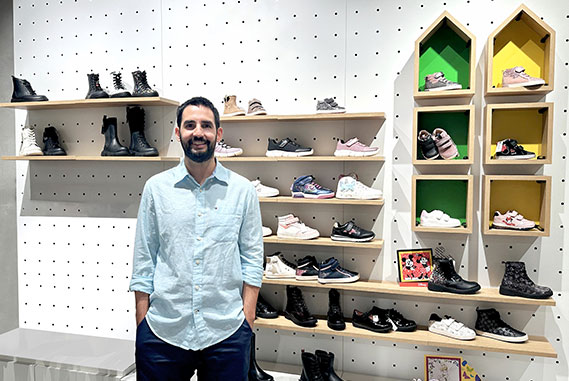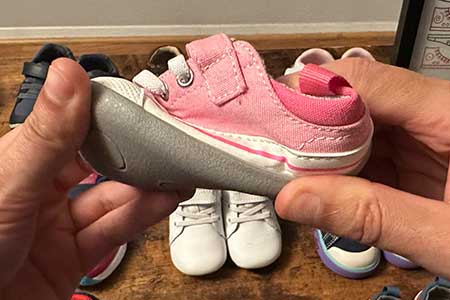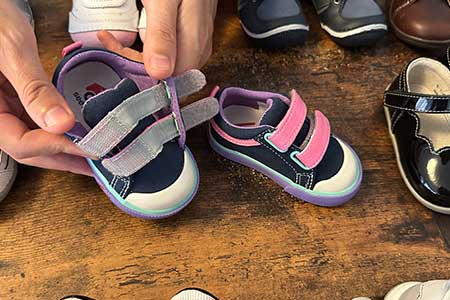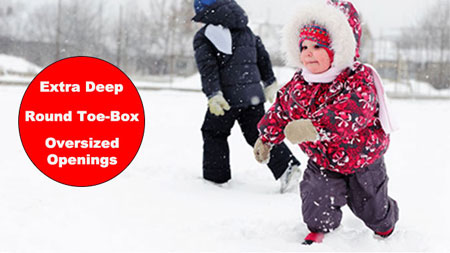Affordable Shoes for Babies Learning How to Walk (That Promote Healthy Foot Development)

Is your baby learning how to walk and you are looking for an affordable pair of first walking shoes to protect your baby’s toes and also foster healthy foot development? As babies learn to walk, their soft and flexible bones need shoes that provide stability without hindering their natural movements. Your baby’s first walking shoes shouldn’t have to blow the family budget, but it’s not simply about picking the cheapest or cutest pair; it’s ensuring they’re conducive to healthy growth. I’ll share some brands and specific styles that offer the best of both worlds: affordability and comfort for those crucial first steps.
My Experience Fitting Babies for Their First Pair of Walking Shoes
I work for a specialized shoe store where we focus on helping children of all ages, from their first steps to their teenage years. After working there for over a decade, I became familiar with the best shoe brands and styles for babies learning how to walk.

I’ll guide you through what you need to know as you set about choosing the appropriate shoes for your baby. You’ll learn why the right first walking shoes can make all the difference, what to look for when picking the perfect pair, and why fit is just as crucial as the design. I will also provide you with specific shoe recommendations.
By the way, it’s important to understand that more expensive shoes don’t automatically translate into better shoes for your baby.
What Makes the Shoes I Recommend Ideal for Babies Learning How to Walk?
The ideal first walking shoes have five distinct characteristics:
1️⃣ The shoes shouldn’t have an elevated heel, in other words, the outsole should be completely flat (zero drop). Your baby’s toes should be completely leveled and flat on the ground, as that’s important for them to get sensory information from the ground.
Take a look at the image below. Do you notice how the Stride Rite shoe on the right (white shoe) has a flat outsole compared to the Nike shoe on the left?

2️⃣ Contrary to some beliefs, shoes for babies learning to walk should not immobilize their feet. Rather, they need to provide protection and slight support, while still allowing the feet to move naturally. This encourages muscles to build strength and supports proper foot development. The shoe should move naturally with your baby’s feet. Below you can find two images of a malleable shoe:


3️⃣ Another important feature is for the shoes to be made of soft, breathable materials like leather or canvas to keep your baby’s feet comfortable and dry.
4️⃣ Non-slip materials can help grip the floor safely.

5️⃣ Oversized openings make it easier to put shoes on and take them off, which can be a daily struggle with an uncooperative little one.

Do Affordable Shoes Translate Into Cheaply Made Shoes?
Affordable doesn’t mean cheaply made. There are brands out there that offer shoes designed with babies’ developmental needs in mind, without the steep price tag. I recommend exploring brands like Stride Rite, Pediped, and Carter’s. These companies produce durable, comfortable, and supportive shoes that cater to new walkers and offer frequent sales and discounts.
What is the Best Way to Save Money On Your Baby’s First Walking Shoes?
My strategy is to look for previous shoe styles that have gone on sale. For example, shoe companies such as Stride Rite, See Kai Run, or Saucony manufacture new shoe styles every year. The previous models that are left behind usually go on sale. There is nothing wrong with these shoes, the shoe company is just trying to get rid of previous inventory.
Shopping during off-season or clearance events can result in finding high-quality baby shoes at a fraction of the cost.
Navigating the Fit: How to Order the Correct Shoe Size Online
Getting the right fit is crucial for babies, especially when they’re learning to walk. Properly sized shoes can make a significant difference in your baby’s comfort and stability as they take those important first steps.
The perfect fit is about more than length. Width plays a vital role too. A shoe that’s too narrow can constrict a baby’s foot, leading to discomfort or even developmental issues. Your baby might not be able to communicate this discomfort, so it’s up to you to ensure their shoes fit well and offer plenty of room for movement.
In my experience, most babies have wide or extra wide feet. If you notice that the top part of your baby’s feet looks puffy or high, that means your baby has a high instep. The natural shape of a baby’s foot is wider at the end of the toes, so it’s important that the shape of the shoe is the shape of your baby’s natural foot. I can help you retrieve your baby’s exact foot length and shape.
After we retrieve the right size and width, we can start looking for the perfect pair of affordable baby shoes. Disclosure: Some links in this post may be affiliate links and we may receive a small commission (at no extra cost to you) when you click our links and make purchases.
Affordable Shoes for Babies Learning How to Walk
I suggest that you take a look at the description below each image to check if that specific style can fit your baby’s foot shape (medium, wide, extra wide, high insteps). Most of the shoes below are APMA approved.
Boys
- Shoe style baby Kylin by Stride Rite
- Available in medium and wide widths
- Rounded edges to decrease stumbles and falls
- Order this shoe a whole size larger than your baby’s current foot size
- Shoe style Hampton by Stride Rite
- Fits medium feet
- Comfy memory foam footbeds
- Removable insoles
- Machine washable
- Order this shoe a whole size larger than your baby’s current foot size
- Shoe style Casey by See Kai Run
- Fits medium and wide feet
- Warm fleece lining with recycled mesh sockliner and cushioned foam insole
- Flexible, rounded, slip-resistant soles
- Order this shoe a whole size larger than your baby’s current foot size
- Shoe style Lucas by See Kai Run
- Fits medium and wide feet
- Seamless construction cradle the baby’s natural shape
- Flexible, rounded, slip-resistant soles
- 100% leather
- Order this shoe a whole size larger than your baby’s current foot size
- Shoe style Ryder II by See Kai Run
- Fits medium and wide feet
- Padded heel and tongue keeps the baby’s feet comfortable
- Wide openings make on and off quick and easy
- Order this shoe half a size larger than your baby’s current foot size
- Shoe style Artie by Stride Rite
- Available in medium, wide, and extra wide widths
- Seamless construction cradle the baby’s natural shape
- Leather lining and insole
- Oversized opening and pull tab on the back offer easy on and off
- Order this shoe a whole size larger than your baby’s current foot size
- Shoe style Splash by Stride Rite
- Available in medium and wide widths
- Seamless construction that cradles the foot’s natural shape
- Oversized opening for easy-on
- Order this shoe half a size larger than your baby’s current foot size
- Shoe style Hayden by Stride Rite
- Fits medium and wide feet
- Double velcro straps
- Flexible, rounded, slip-resistant soles encourage natural motion and help improve balance
- Order this shoe a whole size larger than your baby’s current foot size
Girls
- Shoe style baby Kylin by Stride Rite
- Available in medium and wide widths
- Rounded edges to decrease stumbles and falls
- Order this shoe a whole size larger than your baby’s current foot size
- Shoe style Carson by Stride Rite
- Fits medium feet
- Oversized opening for easy on and off
- Padded tongue and collar
- Order this shoe a whole size larger than your baby’s current foot size
- Shoe style Lucianne by Stride Rite
- Fits medium and wide feet
- Leather and synthetic upper
- Order this shoe half a size larger than your baby’s current foot size
- Shoe style Ryder II by See Kai Run
- Fits medium and wide feet
- Oversized opening for easy on and off
- Flexible, rounded, slip-resistant soles encourage natural motion and help improve balance
- Order this shoe half a size larger than your baby’s current foot size
- Shoe style Cheyenne by Stride Rite
- Fits medium and wide feet
- Rubber outsole is flexible yet durable and provides the needed traction for first steps
- Padded heel and tongue keeps the baby’s feet comfortable
- Order this shoe a whole size larger than your baby’s current foot size
- Shoe style Tobias by Stride Rite
- Available in medium and wide widths
- Oversized opening for easy on and off
- The footbed is crafted with memory foam for enhanced, superior comfort
- Order this shoe a whole size larger than your baby’s current foot size
- Shoe style Natasha by Stride Rite
- Fits medium and wide feet
- Machine washable
- Sensory pods to feel the ground beneath for better traction and grip
- Order this shoe a whole size larger than your baby’s current foot size
- Shoe style Ginny by Stride Rite
- Fits medium and wide feet
- Over-sized opening for easy on/off
- Seamless construction to cradle their natural shape
- Order this shoe a whole size larger than your baby’s current foot size
How Often Should You Replace Your Baby’s Shoes?
As your baby grows and their walking style changes, their footwear needs will also evolve. Typically, a new pair might be necessary every three to five months, if you leave the correct amount of growing room to begin with. If you notice the shoes are snug or your baby’s walking appears impeded, it may be time to go shoe shopping again.
Childhood foot health experts consistently emphasize the importance of balance between shoe time and barefoot time. Allowing babies to walk barefoot helps in the development of foot muscles and coordination.
Should I Allow My Baby to Go Barefoot at Home?
Giving your baby adequate barefoot time at home, under safe conditions, also aids in developing their sense and control of movement. But when those little feet are on rougher, potentially hazardous surfaces or it’s time to go outside, protective and supportive footwear becomes non-negotiable.
Are Booties a Good Choice for Babies Learning How to Walk?
Regular baby footwear, such as soft booties or decorative shoes, might not offer the structured support that first walking shoes do. Those are fine for pre-walkers, but once your baby is up and taking steps, a transition to proper walking shoes should be your next move.
What Socks Are Best for Toddlers Learning How to Walk?
You can get any affordable pair of socks, but please make sure that the socks are the correct size. Socks that are too short and tight can prevent your toddler from freely moving his or her toes. I usually recommend seamless socks for babies as they don’t constrict toe movement. In that resource, I also help you determine exactly what sock size you should order.
Most Foot Problems Are Caused By Ill-Fitting Footwear
Did you know that most foot issues such as bolsters, calluses, and corns are caused by wearing shoes that are either too short or too narrow? Please make sure that your baby is wearing shoes that fit properly.
It’s a fine line between affordability and quality, and as a discerning parent, it’s important to know when a deal is too good to be true. Always check customer reviews, look for reputable brands, and remember the key features that promote healthy foot development. By doing so, you can secure baby shoes that are both cost-effective and beneficial to your little one’s walking journey.
The right shoes can lead to happy, healthy first steps, and isn’t that the goal we all step towards? Let me know if you have any questions in the comments section below or also feel free to email me and I will respond as soon as possible.


















